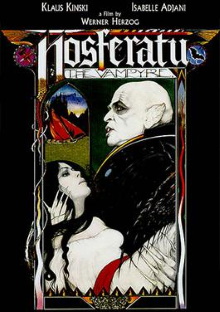
The proper Nosferatu film is of course the 1922 silent one by German director F. W. Murnau but we’ve never watched and judging that it is perhaps a little too difficult to grasp in the present, I decided to skip over it. This one is the 1979 remake by Werner Herzog, once again starring his favorite actor Klaus Kinski. Unfortunately while this is solid work the impact is subdued due to how familiar we all are with the Dracula story and I kept wondering how much of it really comes from the earlier work. I now think maybe I should have watched that instead.
This film begins much like the usual Dracula story save that it begins in the canal-lined streets of Wismar, Germany instead of London. Jonathan Harker from his home there, leaving behind his wife Lucy, to go to Transylvania in order to sell a house to Count Dracula. The encounter between the two plays out as we expect, leaving Jonathan trapped in the castle while Dracula travels to Wismar hidden in a coffin on a ship. Jonathan escapes and makes his way back but is severely drained both by the demands of the journey and being fed on by Dracula. When he arrives he is pale and unable to remember Lucy. As for Dracula when he arrives, he is accompanied both by an enormous swarm of rats and a plague that quickly sweeps across the city, killing large numbers of people. Lucy realizes the nature of the threat by reading Jonathan’s diary and a book about vampires that was given to him by the gypsies but is unable to convince anyone else to act on it.
The cinematography here is as striking as in the other films by Herzog and we can even detect some visual similarities as when Jonathan hikes up a steep hill for example or when the local people transport Dracula’s coffins down a river. Plus I was taken aback at how quickly the city was all but depopulated by the plague and how the government broke down, leaving a post-apocalyptic city that Dracula has free rein in. Yet for the most part, this film is just too similar to all of the other versions that we’re all so familiar with to make much of an impression. Of course this version uses the monstrous, bald nosferatu archetype rather than the suave Dracula one but even this conception of the character isn’t that new. What’s worse is that this version looks creepy as he skulks about in his cloak and Kinski always has a crazed, villainous look about him, but he never actually demonstrates any supernatural powers. It’s just not that spectacular.
What is truly surprising is that the character of Lucy is portrayed as the one with agency to deal with the problem. It seems that this depiction comes right out of the 1922 version of the film as well. After realizing that there is no functioning authority and having failed to convince Van Helsing or anyone else that her fears are warranted, she plans and takes action on her own. The resulting scene of her seducing Dracula while sacrificing herself is sublime and easily the most powerful shot in the whole film. It’s a little ridiculous how Herzog goes out of his way to show that it is the men of science and logic who are wrong this time around but the inherent progressivism of having Lucy be the one to take action like this is impressive.
I still don’t like this very much as the Dracula stories have all been thoroughly played out and there’s just not enough that is different. The Nosferatu look is monstrous, sure, but the film doesn’t do anything with it. Elements like the character’s expressed pathos and the curse of immortality fall flat when you realize that he can kill himself any time he wants through sunlight exposure and I’ve long been cured of that kind of edginess since Vampire: The Masquerade. In the end, there’s just not enough here for me to like and I’m left wondering how much of what I do like is actually from the 1922 version of the film.